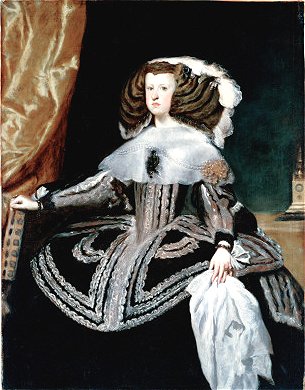 |
|
Portrait of Dona Mariana of Austria - Queen
of Spain as a Young Woman
by Juan Bautista Martinez delMazo - 1652/53
By Sharon Erickson, April 11, 2000
Visitor level 1, 2, &3
Level 1
This is a painting of a young woman of obvious stature and wealth. We know this by the
stance and posture of the figure and by the grandeur of her dress and jewelry.
The figure stands stiffly facing the camera and makes eye contact with the observer. There
is a feeling of aloofness to the figure in keeping with her royal stature. She is dressed
in a very elaborate gown of a dark color with silver embroidery along the skirt, bodice
and sleeves. A double strand of pearls is attached to her wide collar and crosses from
shoulder to shoulder. There are jewels also fastened to the collar. The collar is white
and appears to be satin or silk.
Her hair is very elaborately styled and stands out from her head in pendant ringlets.
Jewels are woven into her hair and white feathers or plums are seen on her head and around
her hair. There are white bows at her wrists and jewels on her wrists and fingers. She
holds a large handkerchief in her left hand. |
In the background is a velvet curtain of a rose color and a table also covered in the
rose velvet. On the table sits a clock.
Level 2
This is a royal portrait of Mariana of Austria when she was the young queen of King Philip
IV. Mariana was Philip's second wife. His first wife, Isabella of Bourbon died and their
son also died. Philip needed an heir to the throne so remarriage was important. It was
also important to marry someone of royal blood. Marianna was the daughter of Philip's
sister, Maria of Hungary. Marianna was to have married Prince Baltasar Carlos, her first
cousin, who died in 1646. Both needed to wed and Philip decided to marry her. Marianna was
14 at the time and Philip was over 40. In spite of their close blood relationship, the
marriage took place to preserve the Habsburg influence in Europe and to provide an heir to
the throne.
Marianna provided three children to the marriage. The first child was a girl who later
became empress of Austria. A son, Prince Felipe Prospero died in childhood and the crown
passed to Prince Carlos, born in 1661. When his father died in 1665 Prince Carlos was only
4 years old and Mariana became regent until the Prince turned 14. Velasquez often painted
these children and their daughter Margarita was the central figure in Las Meninas.
The portrait of Mariana was painted when she was still quite young. Her face is plain but
excessively made up. In spite of her somber expression there is a hint of the cheerful
young women that she was. She was fond of luxury and diversion though her spirit was
oppressed by the somewhat rigorous court ceremonial. Her reign was also overshadowed by
the preoccupation of providing a male heir in a family where the boys were sickly.
The curtains in the background of the portrait mark the royal station of Mariana. Her
hands are fine and aristocratic. Her right hand rests on the back of the chair, which is a
royal position and her prerogative as queen. The left hand carelessly holds a rather large
handkerchief, which was fashionable in the court at the time. The table in the background
draped in scarlet and holding a clock are all symbols of the queen's character. They
indicate that she carried out her duties with great care and with kindness and compassion.
Juan Bautista Martinez del Mazo painted this portrait. Del Mazo was the son-in-law of
Velasquez and worked closely with him. He most accurately copied Velasquez's style and
carried on as the court painter after the death of Velasquez.
Level 3
The painting is quite beautiful in its use of color. There is muted harmony in the browns,
blacks, golds and purple hues. The handkerchief is painted with ample folds and the hand
that holds it is quite elegantly painted with great strokes of white, pink, and black. The
wig on her head is painted with brown, gray, and pink. The golden jewels twinkle on the
silver-gray brocade and braiding. The silhouette of the queen is graceful and commanding.
The pose is natural yet majestic and is free of affectation.
Del Mazo was the artist who most closely copied the technique of Velasquez. His pictures
were of such high quality that they are often attributed to Velasquez and Mazo's own
personality and technique are submerged. Even in his most faithful copies of Velasquez's
portraits, however the experts say his brushwork does not have the imagination and
effectiveness of Velasquez's. He lacks the subtlety and the ability to give the illusion
of reality to the degree that Velasquez's does. In the costumes, hair, and ornaments,
Mazo's brushstrokes are more compact and irregular. The features of the sitters are not as
refined or delicate as Velasquez's. His painting of textures was sometimes flimsy and
lacking in volume. This painting of Queen Mariana, however is considered of very high
quality and was considered a Velasquez until recently.
ringlingdocents.org
|